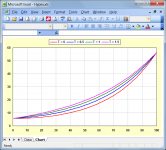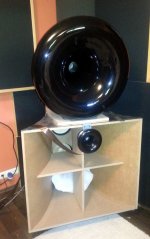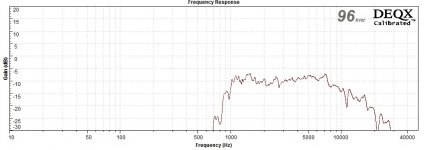Looks beautiful - should sound great. I did a simple all plywood 50Hz design for a friend with GoTo drivers, based on my own horns but eliminating the fibreglass section. I think a short 'L' 50Hz 1/4 wavelength is a good compromise, particularly if one uses a long horn on top to give a lower cross over point to suit the bass horn upper roll off. This all goes to illustrate the strengths of Lynn's solution - time alignment, control of the cross over, living room dimensions.


We wil test 50Hz hypex t=0,3 soon - for 8, 12 or 15".
That's a lot of horn!

I used T=0.6, after playing around with HornResp, but with no great understanding. I understood from Earl G that cut off is mostly just about throat size, mouth, and length. Basically from measurement with a 50Hz 1/4 WL horn you get 80 - 100Hz that's reasonably in control and everything below is room dependent disaster. Perhaps T factor has a greater influence on how the driver is loaded at the top end. I have never really understood on what basis T-factor should be be selected in the Le Cleac'h expansion. Or indeed why it is selectable at all if there is an optimum for constant driver loading. Jean-Michel?
Truetone,
In classical horn design you will find that the T factor is used to load the lower frequency with a slower expansion rate as the T value is increased. The initial throat size does not change, the expansion rate is what is changing. The length and the mouth size stays the same, only the expansion rate is changing. If you look at the expansion rate of an exponential horn you use a factor called M which is the flare rate in that equation, the length that the area doubles is equal to M. T adds another factor to the equation, in other words in a hyperbolic equation you get an extra term which is T which varies this expansion rate. T=0.5 is exactly the same as a standard exponential expansion rate. With a t= 0.6 the rate of expansion in the initial horn flare, the expansion is slightly slower increasing the low frequency loading and only slightly changing the upper frequency response. Increasing the T value makes the rate of change slower in the beginning and faster there after. The high frequency response will become more beamy on axis with the higher values of T.
In classical horn design you will find that the T factor is used to load the lower frequency with a slower expansion rate as the T value is increased. The initial throat size does not change, the expansion rate is what is changing. The length and the mouth size stays the same, only the expansion rate is changing. If you look at the expansion rate of an exponential horn you use a factor called M which is the flare rate in that equation, the length that the area doubles is equal to M. T adds another factor to the equation, in other words in a hyperbolic equation you get an extra term which is T which varies this expansion rate. T=0.5 is exactly the same as a standard exponential expansion rate. With a t= 0.6 the rate of expansion in the initial horn flare, the expansion is slightly slower increasing the low frequency loading and only slightly changing the upper frequency response. Increasing the T value makes the rate of change slower in the beginning and faster there after. The high frequency response will become more beamy on axis with the higher values of T.
T=0.5 is exactly the same as a standard exponential expansion rate.
Hi Kindhornman,
I think you will find that a hyperbolic-exponential horn with T = 1 has a standard exponential expansion rate.
(The expression describing a hyperbolic-exponential horn simplifies down to that of an exponential horn when T = 1).
Kind regards,
David
Attachments
If you look at the expansion rate of an exponential horn you use a factor called M which is the flare rate in that equation, the length that the area doubles is equal to M.
Hi Kindhornman,
For an exponential horn:
m = Ln(S2 / S1) / L12
or
m = 4 * Pi * fc / c
In each case the unit of m is length ^ -1.
m is not equal to the area doubling length.
Area doubling length = Ln(2) / m
or
Area doubling length = Ln(2) * c / (4 * Pi * fc)
(where c = velocity of sound in air, fc = horn flare cutoff frequency)
Kind regards,
David
Would you not recommend the 288/400 to be crossed at 650, like Lynn has done with the Azura 425?
Pano,
If i ever get around to finishing the Altecs and putting the 288 on the jmlc400, you are welcome to have a listen. It wouldnt hurt to have an experienced Altec ear
Of course you can xo the 288 at 650, by all means - what we did here was just to see the potential of the various drivers and horn combinations. The 200T horn apparently Works well Down to 350 hz, so did the 288 (at least with 12 dB). This was, as I said earlier, done to check the limits of both drivers and horns at the very frequency Extremes. The one thing responsible for more bad horn sound than anything else is the stretching of frequencies too far.
There are of course many factors that come into play when it comes to choosing the final xo frequencies; driver, horn, personal preferences and not to forget what will be used BELOW the driver. Right now I am changing back and forth between single/dual GPA 414 Alnicos and similar TAD TM-1201, and the New AutoTech J-horn fitted With GPA 515-8G (a very promising combo BTW).
Autotech always use T=0,8 except JMLC-200 which uses T=0. JMLC-200T uses T=0,8 as well. JMLC-350 has half angle of 7 degrees. It's good for tweeter application especially with new Radian 475-Be that we just received.
Do you have any more information on the 475-Be? Would be interesting with listening impressions, measurements, or info on availability. Thanks.
I have 475 Be in my system for 3 days. First impresion compared to BMS4538 is luck of sharpness and much more detality. I will try to make measurements and post it.
My system is fully active,
2 x SONIDO 300 paraler in 100 Hz JMLC horn (without ane enclusure now)
JMLC270 with BMS4592Nd (only midrange section is used)
JMLC1000 with radian 475 Be (was BMS4538)
xover points 400Hz and 1800Hz done by DEQX
amplifiers firstwatt F5 and LCAudio for biggest horn
My system is fully active,
2 x SONIDO 300 paraler in 100 Hz JMLC horn (without ane enclusure now)
JMLC270 with BMS4592Nd (only midrange section is used)
JMLC1000 with radian 475 Be (was BMS4538)
xover points 400Hz and 1800Hz done by DEQX
amplifiers firstwatt F5 and LCAudio for biggest horn
to my opinion it is the best cofiguration, although 457Be cam be crossed lower than 1,8k i would not suggest treeble form bigger than 1000Hz horn, this I have done before with BMS4592 and the bigger horn the worse treeble JMLC400 was acceptable but sepaating midrange form treeble satisfied me more
David McBean,
Thanks it has been years since I did the math, should have gotten out my book and taken a look. Off the top of my head don't I remember Si=S0 e^mx as exponential with M being the flare constant in an exponential expansion. Been so long since I used the math need to look it up.
Thanks it has been years since I did the math, should have gotten out my book and taken a look. Off the top of my head don't I remember Si=S0 e^mx as exponential with M being the flare constant in an exponential expansion. Been so long since I used the math need to look it up.
- Home
- Loudspeakers
- Multi-Way
- Beyond the Ariel


